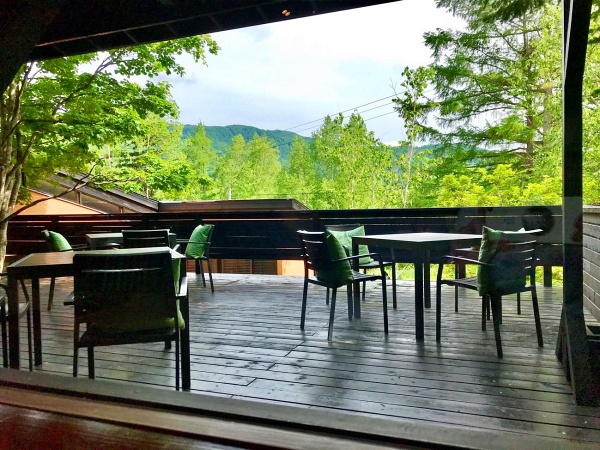Feature
- VISIT YAMAGATA
- Feature
- [Activity] Mt. Kumanodake & Okama in Winter! Go up Zao in snowshoes
[Activity] Mt. Kumanodake & Okama in Winter! Go up Zao in snowshoes
- Zao・Yamagata
- 2023.03.27
Sightseeing・ Short trip・ Activity
Spring Winter Recommended Girls Family Solo Nature Day trip

April is the perfect spring outfit for the city.
At Zao, you can still enjoy the winter scenery.
At this time, Omotenashi Yamagata is holding a snow shoe trekking activity (from late March to early May) to Kumanodake and the Okama crater lake guided with a mountain instructor as described in this article!
Why don’t you go out to see the precious snowy Okama crater lake that can only be seen at this time of year, and enjoy the view from Kumanodake, the highest peak of Zao.
Introduction
Zao full of charms
Zao Onsen is not only the second most strongly acidic sulfur spring in Japan, but also a ski resort boasting a vast area and the presence of its Snow Monsters, rime-covered trees with an appearance woven by a most unique winter nature.
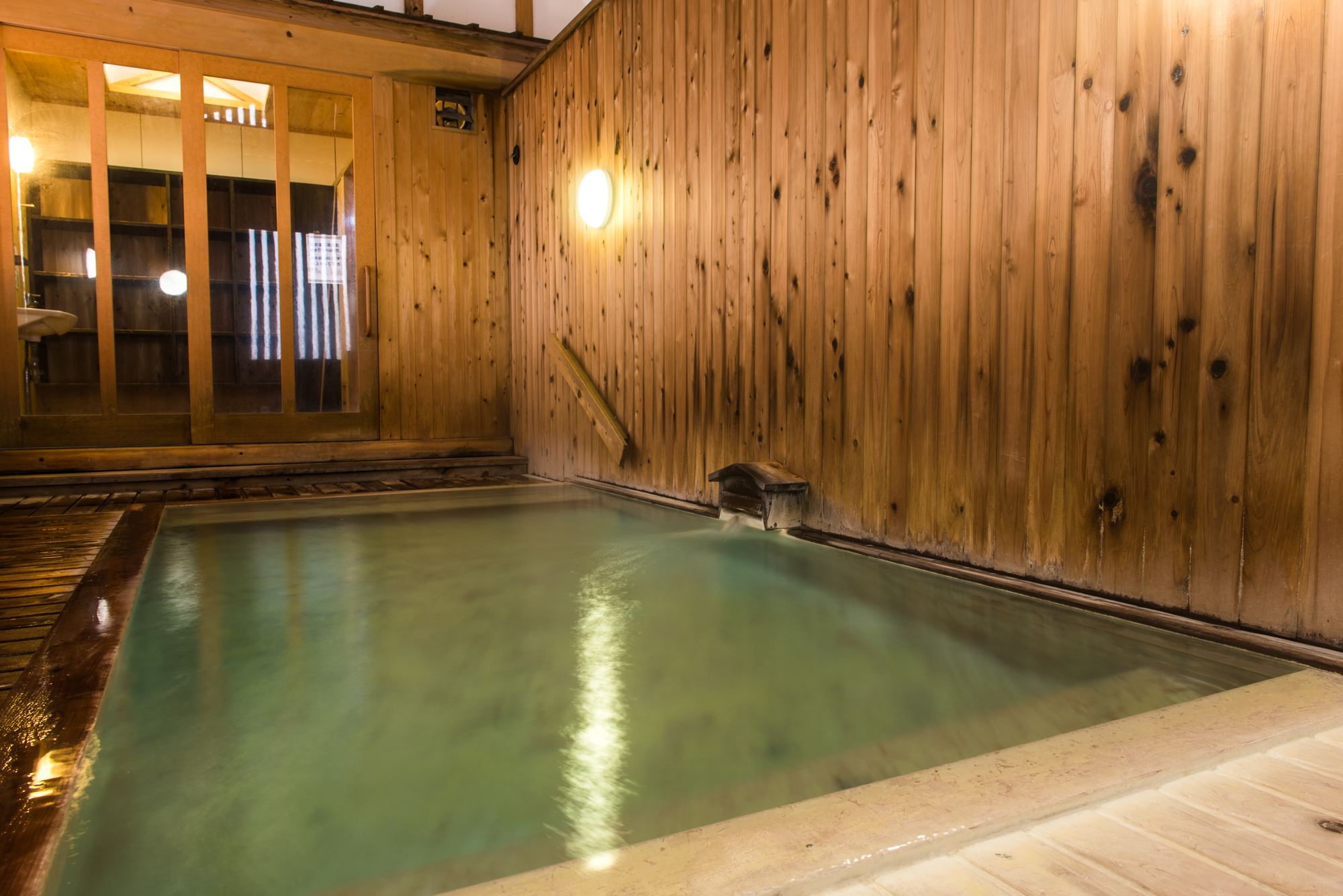


This time, we will introduce a special tour to go to snow trekking with snowshoes to the Okama crater lake for which Zao is known for and mount Kumanodake, the main peak of the Zao mountain range!
The Okama crater lake, symbol of Zao
Many people who have never been to Zao may have heard the name Okama.

Okama is a crater lake surrounded by three peaks, Kattadake, Kumanodake, and Goshikidake, which is located in the corner of the Zao mountain range on the border between Yamagata and Miyagi prefectures.
The lake is filled with emerald green water and has a mysterious atmosphere in contrast to the rough crater wall.

It is also popular as a hiking spot because there are gentle and well-maintained mountain trails.
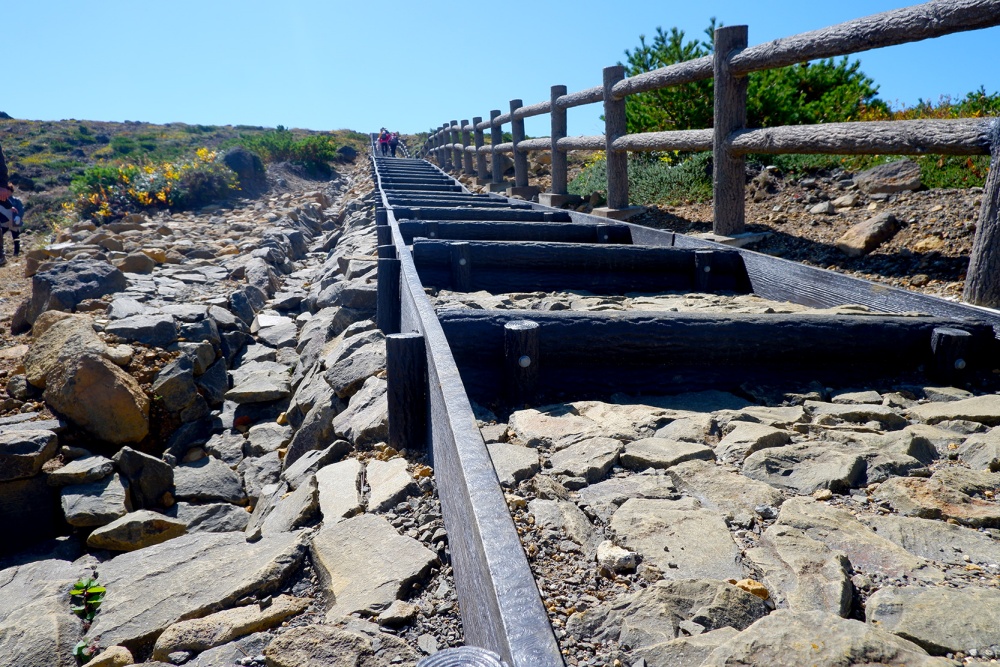
Dicentra peregrina, also called “Queen of Alpine Plants” are in full bloom near the top of the mountain (the best time to see it is around July).

Okama can be accessed from Yamagata City and Sendai City driving on the tourist roads for about 90 minutes.

The tourist roads, Zao Echo Line and Zao High Line, are closed during the winter (November to late April) due to snow, so you cannot usually go see Okama in winter.

Zao Echo Line just after opening
This plan is a valuable plan that takes you on a snowshoes trek to Okama, which you can’t go see during the winter season!
Zao’s main peak Mt. Kumanodake
Zao is famous as a tourist destination, straddling both Yamagata and Miyagi prefectures.
Although it is sometimes called “Mt. Zao,” in reality there is no single peak called as such. Instead, the general term for the mountains that straddle Yamagata and Miyagi prefectures (part of the Ou Mountains) is the Zao mountain range.

Jizo-dake ~ Kumanodake Trail
Another highlight of this plan, where the main peaks of the Zao mountain range are lined up at the Okama crater lake, is Mt. Kumanodake at an altitude of 1,841m.


There is a gentle mountain trail from Okama to the summit of Mt. Kumanodake, so you can easily go trekking this a popular course if you like mountain climbing or have experience in it.
Overview of this plan
Be careful in winter!
As I have introduced so far, Okama and Kumanodake are relatively easy to get to.
However, the snow-covered winter is not the same as during the snowless season.

There are many climbers aiming for Okama and the summit of Mt. Kumanodake even in winter, but every year people get lost and need to be rescued. In some cases, they are only discovered when the snow melts…

Mount Jizo summit
From early summer to autumn when there is no snow and the weather is stable, there is almost no safety issue to reach the summit even without a mountain instructor if you have all the equipment and knowledge. And even in winter, if it’s sunny all the time, it’s not that difficult to go on your own.
However, as you know, the weather in the mountains is variable, and even if it is sunny at the time of departure, it is not uncommon to suddenly be covered with clouds and encounter strong winds and snow.

Therefore, for winter trekking, we highly recommend going accompanied by a mountain instructor who is familiar with the mountains of Zao.
Most of the photos I will use in this article were taken when I was lucky and the weather was nice.
Depending on the weather on the date and time of participation, you may not be able to enjoy trekking in the same condition. In some cases, the ropeway may be suspended due to strong winds, or the mountain instructor may decide that it is dangerous and will give up trekking in the direction of Okama or Kumanodake.

Course to Okama & Kumanodake
The map below indicates the time required for trekking to Okama and Mt. Kumanodake (taken from Zao Ropeway website) when there is no snow in warm season.
* Snowshoe trekking will take longer than indicated here

In this tour, join the mountain instructor at Zao Ropeway Sanroku Station in Zao Onsen Street, and transfer to the Sanroku Line and Sancho Station to reach Jizo Sancho Station. Then, when you arrive at Jizo Sancho Station, first visit the Zao Jizoson statue and then head to the Jizodake summit, aiming for the destination Kumanodake and then Okama.
* The mountain instructor will decide whether to go to the summit of Kumanodake and then look at the Okama, or to see the Okama and then head to the summit of Kumanodake, taking into consideration the weather of the day.
* Since Okama is seen from a point near Kumanodake, this tour does not go to Kattadake.
* Depending on the weather, you may not be able to reach the Okama or Kumanodake, or you may not be able to see the Okama even if you go nearby.
Now, let’s take a look at the details of this tour!
First, take the ropeway to Jizodake
Meet at the foot of the mountain
The meeting place for this plan is the Zao Ropeway Sanroku Station.

Meet the mountain instructor at the free rest area on the 1st floor of the station building.


There are changing rooms and coin lockers in the rest area, so you can change clothes and temporarily store your luggage.

Take ropeway up to the Juyo Kogen Station
After joining the mountain instructor and receiving a simple orienteering, it’s time to start!

First, board the Sanroku Line that connects the Zao Sanroku Station to the Juyo Kogen Station.

It takes about 7 minutes to reach Zao Kogen Station, which is at an altitude of 1,734m.
If it’s sunny, you can see Mt. Gassan, Mt. Chokai, the Asahi mountain range, etc. from the gondola’s windows.

If you are fascinated by the scenery, you will arrive at Juyo Kogen Station in no time.
Take the Sancho line to the Zao Jizo Sancho station
When you arrive at Juhyo Kogen Station, change to the Sancho line.


The distance from Jizo Kogen Station to Jizo Sancho Station is 1,872m, about a 10-minute ride.

The mountain in front is Kumanodake.
It is one of the destinations of the snowshoe trekking tour.


On a windy day, the whole area outside the window is pure white
From the end of March to the beginning of May, which is the period this tour is offered, the rime on the trees has completely collapsed, but around February, when the rime on the trees is at its peak, another world is spreading on the outside of the gondola on the mountaintop line.
 View from the Sancho line around February
View from the Sancho line around February

View from the Sancho line around February
While enjoying the gondola trip, we arrived at the Jizo Sancho Station at an altitude of 1,661m in no time!

The rooftop of the Jizo Sancho station is an observatory, and you can get a panoramic view of the surrounding scenery.
From Jizodake to Kumanodake
Pray for safety at the Zao Jizoson statue
After getting off the Jizo Sancho Station, head to the must-see Zao Jizoson statue.

Built in 1775 , this Jizoson statue is a sitting statue with a height of 2.34m, a shoulder width of 1.2m, a knee width of 1.8m, and a pedestal height of 0.34m.
This Jizoson statue, which has been enshrined in the highlands at an altitude of about 1,660 meters for over 200 years and still watches over the safety of climbers, is famous for being buried in snow during the winter.

As an aside, the Jizoson statue has its face on the ground no matter how much it snows, but in February 2022 the face was not visible!

The whole body disappeared in the snow, and I couldn’t even worship!
(No matter how much Jizo is buried in the snow, I admire the fact that the whole offering box is always on the snow.)
To the summit of Jizodake
After praying to the Zao Jizoson statue for trekking, the snowshoe trek will start!
First, head to the summit of Mt. Jizodake.

The road from the Jizo Sancho station to the top of Jizodake is an uphill slope that is probably the hardest in this snow trekking.
I will take a little break and proceed while admiring the surrounding scenery.

A little 10 minutes after leaving the Zao Jizoson statue.
We arrived at the summit of Jizodake in no time!

It seems that the field of view has opened and it has fallen into another world at once.



However, nothing can be seen in the wind and snow…

Shrimp tail
In sunny trekking, the beauty of the landscape makes it easy to forget the other side of the snowy mountains, but you can still see the strength of the wind and the harshness of nature.
One of them is a lump of snow on a pillar (wooden stick) that serves as a guidepost for trekking (right photo below).

Snow is attached to a thin wooden stick for a surprisingly long time in the lateral direction.
Snow and water droplets blown by the wind from the same direction adhere to trees and rocks, and the type of ice that has accumulated for a long time and rime that has grown snow is called the “shrimp tail.”
The shape on the snow is really like the tail of a fried shrimp!

The stronger the wind, the larger the shape of the tail, so oversized tails are scattered all over the mountaintop.

Walking while looking for a better-shaped shrimp tail may be one of the pleasures of snow trekking.
To Kumanodake
Let’s go to Kumanodake!


White land, distant view, awe of nature~


The world opens and the heart is washed.
Kumanodake summit
Climb to Kumanodake!
40-50 minutes from the summit of Jizodake.
We have arrived at the summit of Kumanodake, one of the highlights of this plan!

It’s a feeling of liberation that makes you want to scream while receiving the power of nature!


Where is Kumano Shrine
On the summit of Kumanodake, the Kumano Shrine, its office, the torii gate, and Mokichi Saito’s monument are erected.

However, even if you look around the mountaintop during this snow trekking season, you will not find any shrines or torii gates.
The only thing you can see is the strangely shaped big snow pile.

Apparently, the pile on the right side of the center of the photo above is the shrine with a red roof, and on the left is the office with a green roof.

▲ Kumano Shrine is in the center, and the office is below the small high part where the man stands.
And where did the big torii and the stone monument disappear?

In the center of the photo below, there is a stone monument with the words Zao Mountain Shrine behind it, and the snow mountain on the right is the torii gate.

To the Okama crater lake
What is the winter appearance of Okama?
After enjoying the scenery at the summit of Kumanodake, head to another main event, Okama !
* Depending on the situation, you may go to Kumanodake after seeing the Okama first.

Okama is usually filled with emerald green lake water.
What’s going on in winter?
Here it is…

The fantastic sight will make you sigh.
It is a precious figure of Okama crater lake that can only be seen at this time of year and only by those who stand here.
Feeling at its peak!

Trekking during snowy weather requires proper equipment and preparation, and is not as easy as during the snowless season.
However, it should be a special one where you can spend a precious time that can only be experienced here.

Participation in this plan
Finally, I would like to introduce the mountain instructor, equipment and belongings that are indispensable for this snowshoes trekking.
Mountain instructor
Indispensable for this tour is the presence of the mountain instructor.

As already mentioned, it is very important to be accompanied by a mountain instructor who has a wealth of mountaineering knowledge and experience when trekking to Okama / Kumanodake during the snowy season in order to avoid distress and to respond to unforeseen circumstances.
Mountain instructor Mr. Kasukawa
They are familkiar not only with safety measures in the mountains, but also with Zao’s flora and fauna, terrain, and other mountains. What is unique to this plan that you can get a broad and deep understanding of the charm of Zao that you can not understand just by walking by yourself.
Equipment & belongings
Snowshoes
The snowshoes used in this snow trekking tour are old-fashioned ring snowshoes.
* Snowshoes rental fee is included in the tour fees.

How to tie a string is a little complicated for first-time users, but let’s wear it under the lecture of the instructor who accompanies you.
In addition, the following equipment is required to participate in snowshoes trekking.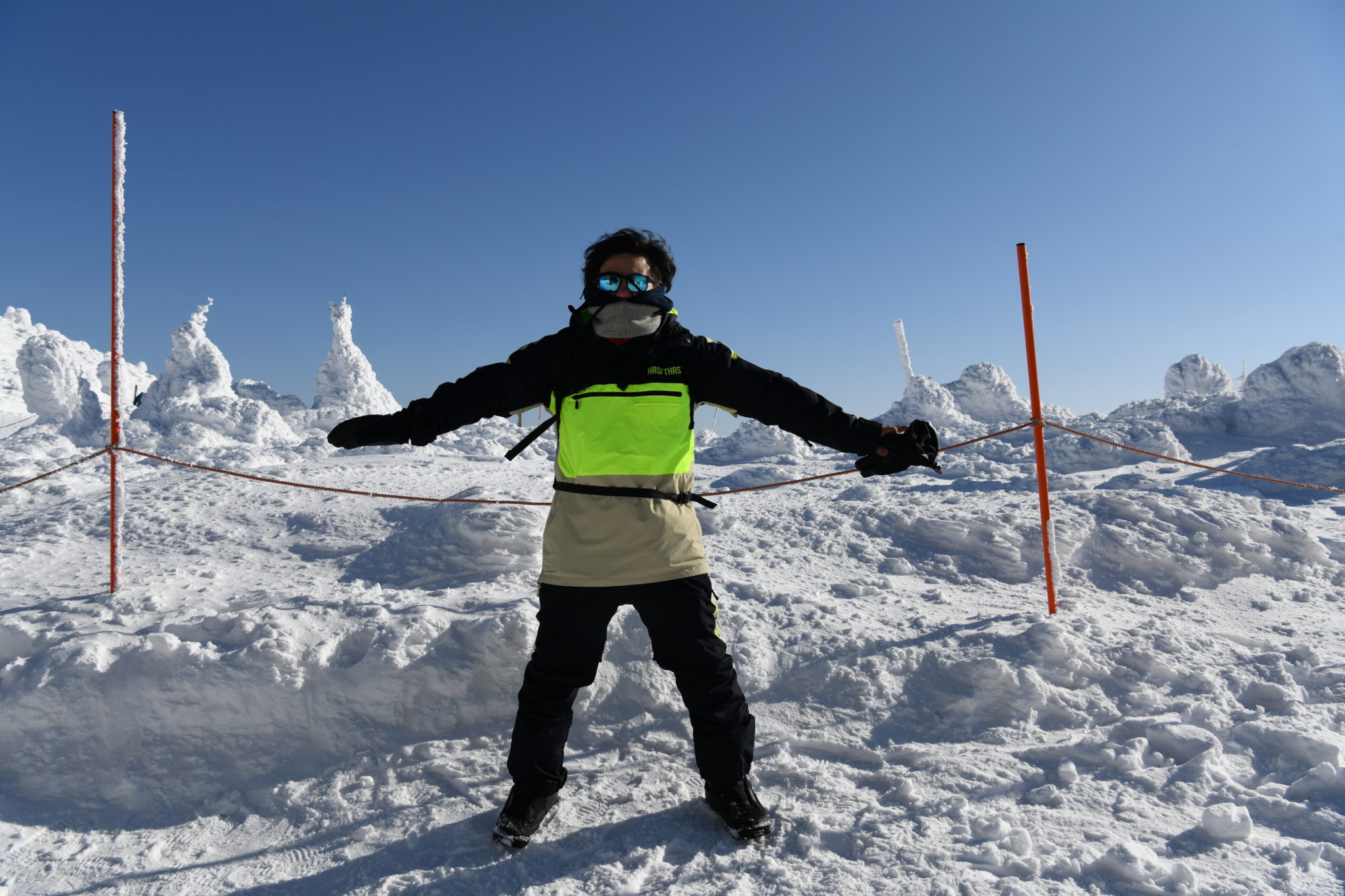
・ Ski wear (or fleece + rainwear for mountaineering)
・ Snow-proof trekking shoes or boots
・ Thick socks
・ Climbing spats (gaiters)
・ Cold-proof gloves
・ Goggles
・ Sunglasses (if sunny)
・ Hat that covers your ears
・ Trekking poles (can be rented)
・ Lunch
・ Drinks
・ Snacks (to eat on the way)
* Climbing equipment (excluding snowshoes) such as ice ax, crampons, and ropes will not be used in this tour.

Ski wear (or fleece + rainwear for mountaineering)
Snowwear is basically layered so that you can take it off when it’s hot and put it on when it’s cold.
[Outlayer]
Ski wear, snowboard wear, rain jackets for mountaineering, etc. that are highly waterproof and breathable
[Middle layer]
Fleece, thin down jacket, soft shell, etc. with excellent heat retention and breathability
[Base layer]
Inner (underwear) with excellent heat retention and quick-drying properties, such as long sleeves on the top and tights on the bottom.
Trekking shoes
Zao’s snow is often not very moist, so regular trekking shoes are fine (applying waterproof spray is recommended).
Thick socks
For this snowshoes trekking tour you will have to walk in the snow for a long time, and as such it is essential to protect your feet from the cold. Thick socks with high protection against the cold and quick-drying properties are recommended to prevent the inside of the shoes from getting stuffy and the feet from getting cold. If you are worried about your feet getting cold, it is safe to wear thin socks as an inner layer in addition to the thick winter mountain socks.
Just in case, it’s safer to bring a pair of extra socks too.
Mountaineering gaiters
The most important thing about your feet is that snow does not get inside your shoes. Therefore, mountaineering gaiters that prevent snow from entering the shoes are a must.
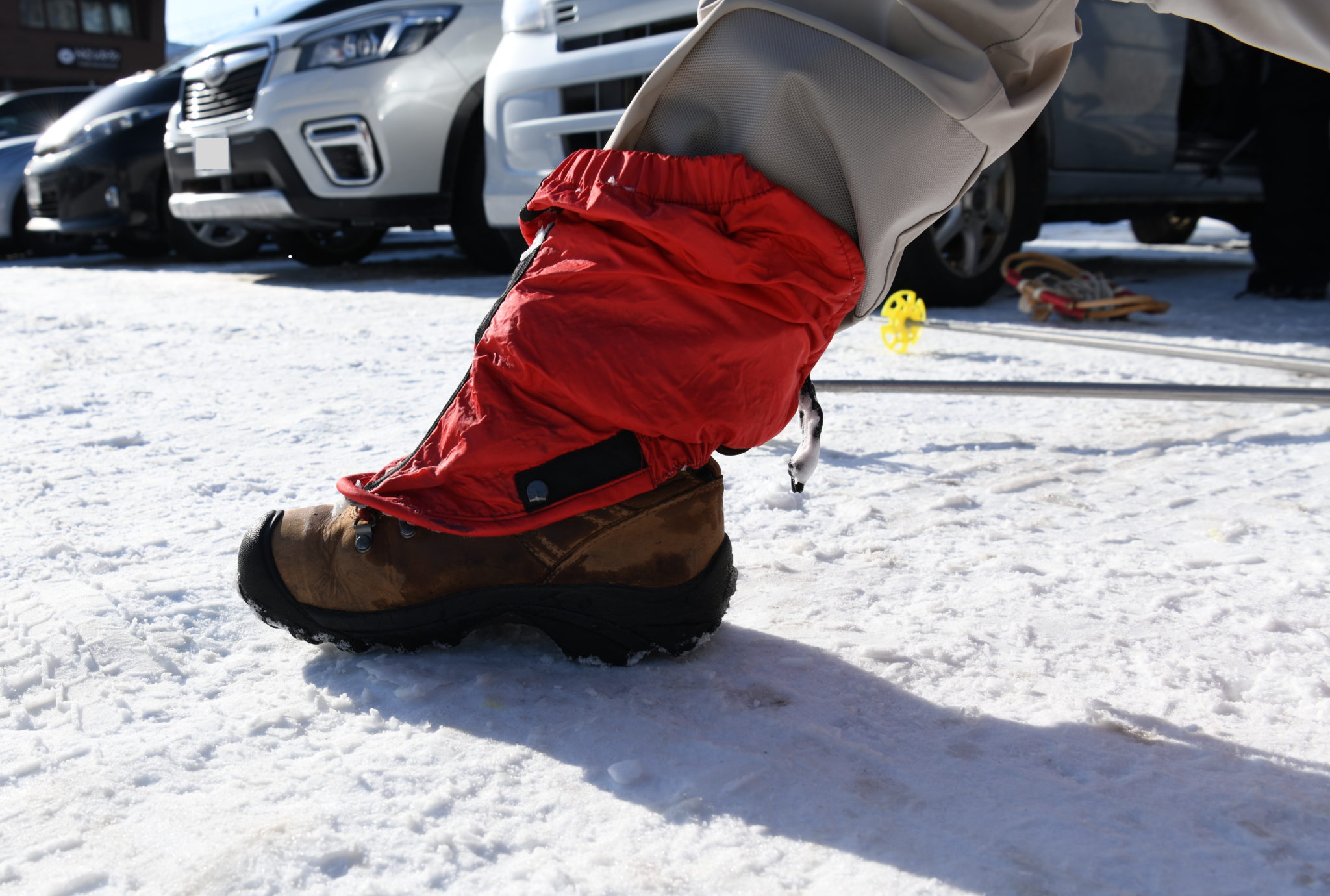
Cold proof gloves
It is safe to use gloves that are waterproof like those for skiing and snowboarding. If you’re worried about your hands, it’s a good idea to wear a warm inner gloves too.
Goggles (or sunglasses)
Sunglasses and goggles are a good idea, as the sun’s reflections are dazzling on sunny days, and on stormy days it can be difficult to open your eyes due to the snowstorm.
Hat that covers your ears
An everyday-use hat can be fine, but it is important that it covers your ears. The best recommendation is a knit hat, but if you don’t have one, don’t forget to bring warm earmuffs.
Snow trekking poles
Poles are also essential for snow trekking up and down snowy mountains. However, these are not ski poles but snowy mountain poles that are used for snow trekking.
The size of the ring is different between snow trekking poles (left on the photo) and ski poles (right on the photo) with the snow trekking poles being larger.
 Left: Snow trekking pole / Right: Ski pole
Left: Snow trekking pole / Right: Ski pole
Ski poles are fine for well-maintained and compacted ski slopes, but when trekking in a field of fresh snow, the ski poles will sink into the snow.
* If you do not have your own we can make reservations for you to rent the snow trekking poles (the snow trekking poles renting fee is not inculded in this tour).

Differences when each stock is stabbed in the snow surface (left: snowy mountain stock / right: ski pole)
Lunch, drinks & snacks
Lunch will be taken during the trek in the snow.
The recommended items are sandwiches and such.

Instructor’s lunch
On the other hand, we do not recommend rice balls and other rice-based products due to the freezing temperatures.
The rice will be very hard and no longer delicious by the time the rice balls are taken out of the backpack at lunch time.
If you are willing to bring hot water in a container with high heat retention, you can bring cup ramen or food that you can rehydrate with hot water and eat.
* The use of fire, burners, etc. is strictly prohibited in the area.

An example of lunch: cup noodles (lower left) / porridge that is completed by pouring hot water and stirring (lower center) / miso soup (lower right) / strawberry (upper left) / side dish bread (upper right)
Bottles of 500 ml of drinks, such as sports drinks or tea, will be enough
* If you are worried, please bring more, but please note that there are no toilets on the course.
* You will have to carry back all your garbage with you.
In addition to lunch, be sure to bring snacks that can supply energy and nutrition.
Application
Mt. Kumanodake & Okama in Winter! Go up Zao in snow shoes
Fees (tax included, in total)
For 1: 29,000 yen
For 2: 34,000 yen
For 3: 39,00 yen
For 4: 44,000 yen
For 5: 50,000 yen
Includes
Round-trip ropeway tickets
Snowshoe rental
Mountain instructor fee
Insurance premiums
* All items not included like clothing and lunch, etc. must be prepared by the participants before the tour
Period
March 18 to May 7, 2024
*Depending on snow conditions
Age requirement
18 years old and over
Accommodation
None (day trip)
Meal
Please prepare your own lunch.
Tour conductor
None
Minimum number of participants
1 person
Travel Terms & Conditions
Click here to read them. (Japanese only) (English version will be sent to you upon inquiry by email)
Others
※ The schedule can be changed if required
※ Paid options including car service from Yamagata station can be added
※ Please contact us be email before making a reservation online if you are visiting Yamagata from overseas
※ The mountain instructors speak only Japanese
※ A translator can join you on the tour for additional fees
✉️ info@visityamagata.jp
☎︎ 023-631-9522
Planning and Implementation
Omotenashi Yamagata Co., Ltd.
Yamagata Governor’s Registered Travel Agency No. 2-295
2-4-3 Honcho, Yamagata City, Yamagata Prefecture
Member of the National Association of Travel Agencies
Business days and hours: Monday to Friday from 8:30 to 17:15
Detailed information

-
Click here for reservations
023-631-9522023-631-9522

![[Feature] Pino Collina Matsugaoka! Winery & Restaurant in Shonai](https://www.visityamagata.jp/wp/wp-content/uploads/2024/06/pinocollina.jpg)
![[Feature] Sahato Benihana! Enjoy the starry sky at the prefecture’s largest planetarium](https://www.visityamagata.jp/wp/wp-content/uploads/2024/07/sahato.jpg)
![[Summary] Safflower Festival 2024! Discover Yamagata’s prefectural flower](https://www.visityamagata.jp/wp/wp-content/uploads/2021/06/紅花①.jpg)
![[Feature] Miraini! Sakata Activity Hub](https://www.visityamagata.jp/wp/wp-content/uploads/2024/02/compile-image_1707742235039.png)
![[Feature] Yukotto! Refreshing time in hot springs](https://www.visityamagata.jp/wp/wp-content/uploads/2024/03/yukotto.jpg)
![[Zao Onsen Ski Resort] Lift & Ropeway Common Ticket (2022-2023)](https://www.visityamagata.jp/wp/wp-content/uploads/2019/12/nat219.jpg)

